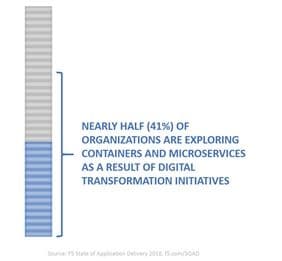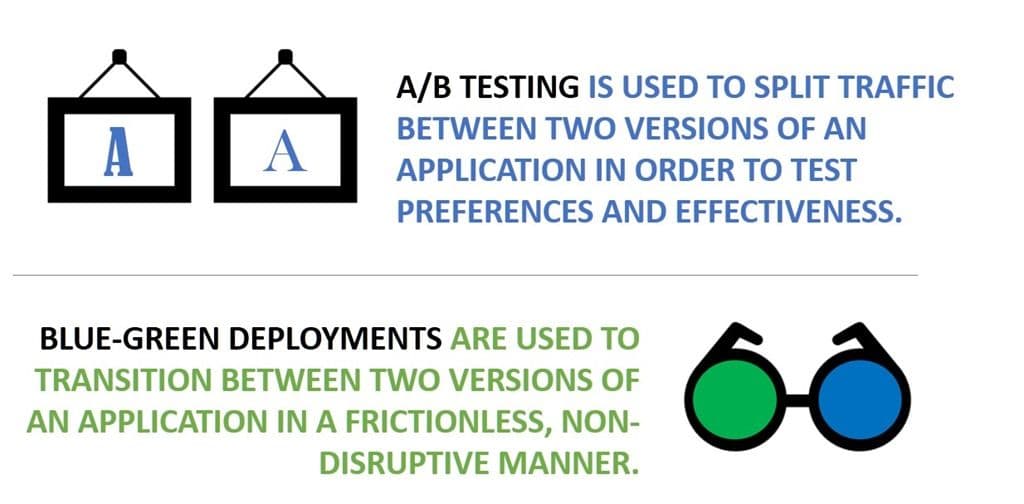
- Today’s fast-paced, digitally-enabled data centers need to be able to direct traffic, not just distribute it.
- Red Hat OpenShift is in use by 21% of respondents according to the State of Application Delivery 2018.
- A/B Testing and Blue/Green Deployments are beneficial deployment patterns that assist in meeting business and operational goals by intelligently directing requests.
- F5 Container Connector facilitates real-time control plane integration of BIG-IP with container orchestration environments that enables A/B testing and Blue/Green deployments with Red Hat OpenShift.
- Because Red Hat OpenShift has a native Kubernetes distribution, the F5 integration for OpenShift utilizes the same controller as the F5 Integration for Kubernetes (
k8s-bigip-ctlr) which is available on Dockerhub or Github.
For too long, the role of a load balancing proxy has been simply to make sure every request got a speedy response. Plain Old Load Balancing (POLB). POLB uses algorithms to distribute requests across a pool of resources. Round robin. Least connections. Fastest Response. The focus of these algorithms is always on the destination; on selecting a resource that is available and fast to provide a response and get it on its way back to an impatient user. The goal is availability, and POLB certainly meets that expectation.
Now, that’s useful, but scaling modern applications is more than just about selecting the right algorithm – it’s about enabling architectures. Scaling modern applications – particularly those deployed in container environments – requires the ability to not just distribute but direct requests. The goal is to realize efficiency and agility of both the infrastructure and the business, and that’s something POLB can’t realize. We have to go beyond POLB if we want to support modern deployment patterns like A/B testing and Blue/Green Deployments that helps operations move as fast as the business needs to.

That requires a smart proxy that can not only distribute requests but direct them based on a variety of information available from the client, the network, and the environment in which they are operating. An L7 proxy, if you prefer. Whatever we call it, it’s smart enough to be able to parse and understand a request from top (HTTP) to bottom (IP) and be able to make decisions as to where to direct a request.
In this post, we’re spotlighting the ability to easily configure and implement A/B testing and Blue/Green deployment patterns, both of which require some smarts at the proxy in order to intelligently direct requests to the appropriate resources.
In containerized environments, this requires the ability to integrate with the container orchestration environment (COE) as well as intelligently direct traffic.
That’s what F5 Container Connector for Red Hat OpenShift provides today. It’s the containerized ‘glue’ between OpenShift and F5 BIG-IP that enables us to intelligently shift traffic from one version of an application to another (blue-green) or enable a comparison-based test between two versions of the same app so the business can make a decision based on data from real visitors.
You can read more about the details on both in the documentation, or grab your own copy of our F5 Container Connector on Dockerhub or Github and get started with these advanced deployments today.
About the Author

Related Blog Posts

AppViewX + F5: Automating and orchestrating app delivery
As an F5 ADSP Select partner, AppViewX works with F5 to deliver a centralized orchestration solution to manage app services across distributed environments.

Build a quantum-safe backbone for AI with F5 and NetApp
By deploying F5 and NetApp solutions, enterprises can meet the demands of AI workloads, while preparing for a quantum future.

F5 ADSP Partner Program streamlines adoption of F5 platform
The new F5 ADSP Partner Program creates a dynamic ecosystem that drives growth and success for our partners and customers.
F5 NGINX Gateway Fabric is a certified solution for Red Hat OpenShift
F5 collaborates with Red Hat to deliver a solution that combines the high-performance app delivery of F5 NGINX with Red Hat OpenShift’s enterprise Kubernetes capabilities.
F5 Silverline Mitigates Record-Breaking DDoS Attacks
Malicious attacks are increasing in scale and complexity, threatening to overwhelm and breach the internal resources of businesses globally. Often, these attacks combine high-volume traffic with stealthy, low-and-slow, application-targeted attack techniques, powered by either automated botnets or human-driven tools.
Phishing Attacks Soar 220% During COVID-19 Peak as Cybercriminal Opportunism Intensifies
David Warburton, author of the F5 Labs 2020 Phishing and Fraud Report, describes how fraudsters are adapting to the pandemic and maps out the trends ahead in this video, with summary comments.
